Microscopic, Spectroscopic and Chemical Analysis of Emeralds from Habachtal, Austria
Abstract
1. Introduction
1.1. General Information on Emeralds—Historical Sources
1.2. Geological Setting of Emeralds from Habachtal (Austria)
2. Materials and Methods
3. Results and Discussion
3.1. Macroscopic, Microscopic and Gemmological Characteristics
3.2. Raman Spectroscopy
3.3. Photoluminescence (PL) Spectroscopy
3.4. Fourier Transform Infrared Spectroscopy (FTIR)
3.5. Ultraviolet-Visible–Near-Infrared Spectroscopy (UV-Vis–NIR)
3.6. Energy Dispersive X-Ray Fluorescence (EDXRF)
3.7. Laser Ablation—Inductively Coupled Plasma—Mass Spectrometry (LA–ICP–MS)
3.8. Associated Minerals and Minerals Inclusions Identified by Raman Spectroscopy
3.9. Austrian Emeralds vs. Egyptian Emeralds
4. Conclusions
Supplementary Materials
Author Contributions
Funding
Data Availability Statement
Acknowledgments
Conflicts of Interest
References
- Groat, L.A.; Giuliani, G.; Marshall, D.D.; Turner, D. Emerald Deposits and Occurrences: A Review. Ore Geol. Rev. 2008, 34, 87–112. [Google Scholar] [CrossRef]
- Giuliani, G.; Groat, L.; Marshall, D.; Fallick, A.; Branquet, Y. Emerald Deposits: A Review and Enhanced Classification. Minerals 2019, 9, 105. [Google Scholar] [CrossRef]
- Sinkankas, J. Emerald and Other Beryls; Geoscience Press: Prescott, AZ, USA, 1981. [Google Scholar]
- Bauer, M. Precious Stones; Dover Publications, Inc.: New York, NY, USA, 1968. [Google Scholar]
- Webster, R.; Read, P. Gems: Their Sources, Descriptions, and Identification, 5th ed.; Butterworth-Heinemann: Oxford, UK, 1994. [Google Scholar]
- Read, P. Gemmology, 3rd ed.; NAG Press: London, UK, 1991. [Google Scholar]
- Lane, K. Emeralds. New World Objects of Knowledge: A Cabinet of Curiosities; Thurner, M., Pimentel, J., Eds.; University of London Press: London, UK, 2021; pp. 159–169. [Google Scholar]
- Giuliani, G. Émeraudes, Tout Un Monde; Les Editions du Piat, Galvenas-F-43200: Saint-Julien-de-Pinet, France, 2022. [Google Scholar]
- Saeseaw, S.; Pardieu, V.; Sangsawong, S. Three-Phase Inclusions in Emerald and Their Impact on Origin Determination. Gems Gemol. 2014, 50, 114–132. [Google Scholar] [CrossRef]
- Renfro, N.D.; Koivula, J.I.; Muyal, J.; McClure, S.F.; Schumacher, K.; Shigley, J.E. Inclusions in Natural, Synthetic, and Treated Emerald. Gems Gemol. 2016, 52, 402–403. [Google Scholar] [CrossRef]
- Saeseaw, S.; Renfro, N.D.; Palke, A.C.; Sun, Z.; McClure, S.F. Geographic Origin Determination of Emerald. Gems Gemol. 2019, 55, 614–646. [Google Scholar] [CrossRef]
- Aurisicchio, C.; Grubessi, O.; Zecchini, P. Infrared Spectroscopy and Crystal Chemistry of the Beryl Group. Can. Mineral. 1994, 32, 55–68. [Google Scholar]
- Wood, D.L.; Nassau, K. The Characterization of Beryl and Emerald by Visible and Infrared Absorption Spectroscopy. Am. Mineral. 1968, 53, 777–800. [Google Scholar]
- Don Goldman, S.; Rossman, G.R.; Parkin, K.M. Channel Constituents in Beryl. Phys. Chem. Miner. 1978, 3, 225–235. [Google Scholar] [CrossRef]
- Huong, L.T.-T.; Häger, T.; Hofmeister, W. Confocal Micro-Raman Spectroscopy: A Powerful Tool to Identify Natural And Synthetic Emeralds. Gems Gemol. 2010, 46, 36–41. [Google Scholar] [CrossRef]
- Fukuda, J.; Shinoda, K. Coordination of Water Molecules with Na+ Cations in a Beryl Channel as Determined by Polarized IR Spectroscopy. Phys. Chem. Miner. 2008, 35, 347–357. [Google Scholar] [CrossRef]
- Wang, H.; Shu, T.; Chen, J.; Guo, Y. Characteristics of Channel-Water in Blue-Green Beryl and Its Influence on Colour. Crystals 2022, 12, 435. [Google Scholar] [CrossRef]
- Della Ventura, G.; Radica, F.; Bellatreccia, F.; Freda, C.; Cestelli Guidi, M. Speciation and Diffusion Profiles of H2O in Water-Poor Beryl: Comparison with Cordierite. Phys. Chem. Miner. 2015, 42, 735–745. [Google Scholar] [CrossRef]
- Karampelas, S.; Al-Shaybani, B.; Mohamed, F.; Sangsawong, S.; Al-Alawi, A. Emeralds from the Most Important Occurrences: Chemical and Spectroscopic Data. Minerals 2019, 9, 561. [Google Scholar] [CrossRef]
- Karampelas, S.; Kiefert, L.; Bersani, D.; Vandenabeele, P. Gems and Gemmology; Springer International Publishing: Cham, Switzerland, 2020; ISBN 978-3-030-35448-0. [Google Scholar]
- Oller Guzmán, J. From the Sea, to the River, Throught the Desert. Some Issues Regarding the Emerald Trade Network in Roman Egypt. In Networked Spaces: The Spatiality of Networks in the Red Sea and Western Indian Ocean; MOM Editions: Lyon, France, 2022. [Google Scholar]
- Jennings, R.H.; Kammerling, R.C.; Kovaltchouk, A.; Calderon, G.P.; El Baz, M.K.; Koivula, J.I. Emeralds and Green Beryls of Upper Egypt. Gems Gemol. 1993, 29, 100–115. [Google Scholar] [CrossRef]
- Abdel Gawad, A.E.; Ene, A.; Skublov, S.G.; Gavrilchik, A.K.; Ali, M.A.; Ghoneim, M.M.; Nastavkin, A.V. Trace Element Geochemistry and Genesis of Beryl from Wadi Nugrus, South Eastern Desert, Egypt. Minerals 2022, 12, 206. [Google Scholar] [CrossRef]
- Khedr, M.Z.; Saleh, G.M.; Abdelfadil, K.M.; Takazawa, E.; Abdelrahman, K.; Tamura, A.; El-Shafei, S.A. The Geology and Mineral Chemistry of Beryl Mineralization, South Eastern Desert, Egypt: A Deeper Insight into Genesis and Distribution. Minerals 2024, 14, 465. [Google Scholar] [CrossRef]
- Harrell, J. Archaeological Geology of the World’s First Emerald Mine. Geosci. Can. 2004, 31, 69–76. [Google Scholar]
- Giuliani, G.; Chaussidon, M.; Schubnel, H.-J.; Piat, D.H.; Rollion-Bard, C.; France-Lanord, C.; Giard, D.; de Narvaez, D.; Rondeau, B. Oxygen Isotopes and Emerald Trade Routes Since Antiquity. Science 2000, 287, 631–633. [Google Scholar] [CrossRef]
- Schmetzer, K. History of Emerald Mining in the Habachtal Deposit of Austria, Part I. Gems Gemol. 2021, 57, 338–371. [Google Scholar] [CrossRef]
- Grundmann, G.; Koller, F. Exkursion: Das Smaragdbergwerk Im Habachtal, Land Salzburg, Österreich. Mitteilungen Der Osterr. Mineral. Ges. 2003, 148, 317–343. [Google Scholar]
- Grundmann, G.; Morteani, G. Emerald Mineralization during Regional Metamorphism; the Habachtal (Austria) and Leydsdorp (Transvaal, South Africa) Deposits. Econ. Geol. 1989, 84, 1835–1849. [Google Scholar] [CrossRef]
- Zwaan, J.C. (Hanco) Gemology, Geology and Origin of the Sandawana Emerald Deposits, Zimbabwe. Scr. Geol. 2006, 131, 1–211. [Google Scholar]
- Nwe, Y.Y.; Grundmann, G. Evolution of Metamorphic Fluids in Shear Zones: The Record from the Emeralds of Habachtal, Tauern Window, Austria. Lithos 1990, 25, 281–303. [Google Scholar] [CrossRef]
- Grundmann, G. Metamorphic Evolution of the Habach Formation A Review. Mitteilungen Der Osterr. Geol. Ges. 1989, 81, 133–149. [Google Scholar]
- Schmetzer, K. History of Emerald Mining in the Habachtal Deposit of Austria, Part II. Gems Gemol. 2022, 58, 18–46. [Google Scholar] [CrossRef]
- Gübelin, E.J. Emerald from Habachtal. J. Gemmol. 1956, 5, 342–361. [Google Scholar] [CrossRef]
- Franz, C.; Grundmann, G.; Ackermand, D. Rock Forming Beryl from a Regional Metamorphic Terrain (Tauern Window, Austria): Parageneses and Crystal Chemistry. TMPM Tschermaks Mineral. Und Petrogr. Mitteilungen 1986, 35, 167–192. [Google Scholar] [CrossRef]
- Grundmann, G.; Morteani, G. The Young Uplift and Thermal History of the Central Eastern Alps (Austria/Italy), Evidence from Apatite Fission Track Ages. Jahrb. Der Geol. Bundesanst. 1985, 128, 197–216. [Google Scholar]
- Aurisicchio, C.; Conte, A.M.; Medeghini, L.; Ottolini, L.; De Vito, C. Major and Trace Element Geochemistry of Emerald from Several Deposits: Implications for Genetic Models and Classification Schemes. Ore Geol. Rev. 2018, 94, 351–366. [Google Scholar] [CrossRef]
- Gübelin, E. On the Nature of Mineral Inclusions in Gemstnes. J. Gemmol. 1969, 11, 149–192. [Google Scholar] [CrossRef]
- Kane, R.E.; Boehm, E.W.; Overlin, S.D.; Dirlam, D.M.; Koivula, J.I.; Smith, C.P. A Gemological Pioneer: Dr. Edward J. Gübelin. Gems Gemol. 2005, 41, 298–327. [Google Scholar] [CrossRef]
- Thomas, R.; Davidson, P.; Rericha, A. Emerald from the Habachtal: New Observations. Miner. Pet. 2020, 114, 161–173. [Google Scholar] [CrossRef]
- Vertriest, W.; Palke, A.C.; Renfro, N.D. Field Gemology: Building a Research Collection and Understanding the Development of Gem Deposits. Gems Gemol. 2019, 55, 490–511. [Google Scholar] [CrossRef]
- Nikopoulou, M.; Karampelas, S.; Gaillou, E.; Hennebois, U.; Maouche, F.; Herreweghe, A.; Papadopoulou, L.; Melfos, V.; Kantiranis, N.; Nectoux, D.; et al. Non-Destructive Study of Egyptian Emeralds Preserved in the Collection of the Museum of the Ecole Des Mines. Minerals 2023, 13, 158. [Google Scholar] [CrossRef]
- Jehlička, J.; Culka, A.; Bersani, D.; Vandenabeele, P. Comparison of Seven Portable Raman Spectrometers: Beryl as a Case Study. J. Raman Spectrosc. 2017, 48, 1289–1299. [Google Scholar] [CrossRef]
- Bersani, D.; Azzi, G.; Lambruschi, E.; Barone, G.; Mazzoleni, P.; Raneri, S.; Longobardo, U.; Lottici, P.P. Characterization of Emeralds by Micro-Raman Spectroscopy. J. Raman Spectrosc. 2014, 45, 1293–1300. [Google Scholar] [CrossRef]
- Moroz, I.; Roth, M.; Boudeulle, M.; Panczer, G. Raman Microspectroscopy and Fluorescence of Emeralds from Various Deposits. J. Raman Spectrosc. 2000, 31, 485–490. [Google Scholar] [CrossRef]
- Hagemann, H.; Lucken, A.; Bill, H.; Gysler-Sanz, J.; Stalder, H.A. Polarized Raman Spectra of Beryl and Bazzite. Phys. Chem. Miner. 1990, 17, 395–401. [Google Scholar] [CrossRef]
- Huong, L.T. Microscopic, Chemical and Spectroscopic Investigations on Emeralds of Various Origins. Ph.D. Thesis, Pharmazie und Geowissenschaften der Johannes Gutenberg-Universität Mainz, Mainz, Germany, 2008. [Google Scholar]
- Nikopoulou, M.; Karampelas, S.; Tsangaraki, E.; Papadopoulou, L.; Katsifas, C.; Nazlis, I.; Touloumtzidou, A.; Melfos, V.; Kantiranis, N. Study of Green-coloured Gems of the Roman Period from the Collections of the Archaeological Museum of Thessaloniki (Greece) and Their Possible Geographic Origin. J. Raman Spectrosc. 2024, 55, 1341–1354. [Google Scholar] [CrossRef]
- Moroz, I.; Panczer, G.; Roth, M. Laser-Induced Luminescence of Emeralds from Different Sources. J. Gemmolgy 1998, 26, 316–320. [Google Scholar] [CrossRef]
- Bersani, D.; Lottici, P.P. Applications of Raman Spectroscopy to Gemology. Anal. Bioanal. Chem. 2010, 397, 2631–2646. [Google Scholar] [CrossRef] [PubMed]
- Wood, D.L. Absorption, Fluorescence, and Zeeman Effect in Emerald. J. Chem. Phys. 1965, 42, 3404–3410. [Google Scholar] [CrossRef]
- Karampelas, S.; Gaillou, E.; Herreweghe, A.; Maouche, F.; Hennebois, U.; Leblan, S.; Sainte Beuve, B.M.; Lechartier, M.; Nectoux, D.; Delaunay, A. A Gemological and Spectroscopic Study with Mobile Instruments of “Emeralds” from the Coronation Crown of Napoleon III. Gems Gemol. 2022, 58, 168–183. [Google Scholar] [CrossRef]
- Thompson, D.B.; Kidd, J.D.; Åström, M.; Scarani, A.; Smith, C.P. A Comparison of R-Line Photoluminescence of Emeralds from Different Origins. J. Gemmol. 2014, 34, 334–343. [Google Scholar] [CrossRef]
- Van Meerbeeeck, M. IR and UV-Vis Spectroscopy of Gem Emeralds: A Tool to Differentiate Natural, Synthetic and/or Treated Stones. Master’s Thesis, Universiteit Gent, Ghent, Belgium, 2009. [Google Scholar]
- De Araújo Neto, J.F.; Barreto, S.d.B.; Carrino, T.A.; Müller, A.; Santos, L.C.M.d.L. Mineralogical and Gemological Characterization of Emerald Crystals from Paraná Deposit, NE Brazil: A Study of Mineral Chemistry, Absorption and Reflectance Spectroscopy and Thermal Analysis. Braz. J. Geol. 2019, 49, e20190014. [Google Scholar] [CrossRef]
- Calligaro, T.; Dran, J.-C.; Poirot, J.-P.; Querré, G.; Salomon, J.; Zwaan, J.C. PIXE/PIGE Characterisation of Emeralds Using an External Micro-Beam. Nucl. Instrum. Methods Phys. Res. B 2000, 161–163, 769–774. [Google Scholar] [CrossRef]
- Bersani, D.; Aliatis, I.; Tribaudino, M.; Mantovani, L.; Benisek, A.; Carpenter, M.A.; Gatta, G.D.; Lottici, P.P. Plagioclase Composition by Raman Spectroscopy. J. Raman Spectrosc. 2018, 49, 684–698. [Google Scholar] [CrossRef]
- Tutti, F.; Lazor, P. Temperature-Induced Phase Transition in Phlogopite Revealed by Raman Spectroscopy. J. Phys. Chem. Solids 2008, 69, 2535–2539. [Google Scholar] [CrossRef]
- McKeown, D.A.; Bell, M.I.; Etz, E.S. Raman Spectra and Vibrational Analysis of the Trioctahedral Mica Phlogopite. Am. Mineral. 1999, 84, 970–976. [Google Scholar] [CrossRef]
- Tlili, A.; Smith, D.C.; Beny, J.-M.; Boyer, H. A Raman Microprobe Study of Natural Micas. Miner. Mag. 1989, 53, 165–179. [Google Scholar] [CrossRef]
- Wang, A.; Freeman, J.J.; Jolliff, B.L. Understanding the Raman Spectral Features of Phyllosilicates. J. Raman Spectrosc. 2015, 46, 829–845. [Google Scholar] [CrossRef]
- Li, H.; Zhang, L.; Christy, A.G. The Correlation Between Raman Spectra and the Mineral Composition of Muscovite and Phengite. In Ultrahigh-Pressure Metamorphism; Elsevier: Amsterdam, The Netherlands, 2011; pp. 187–212. [Google Scholar]
- Bersani, D.; Andò, S.; Scrocco, L.; Gentile, P.; Salvioli-Mariani, E.; Fornasini, L.; Lottici, P.P. Composition of Amphiboles in the Tremolite–Ferro–Actinolite Series by Raman Spectroscopy. Minerals 2019, 9, 491. [Google Scholar] [CrossRef]

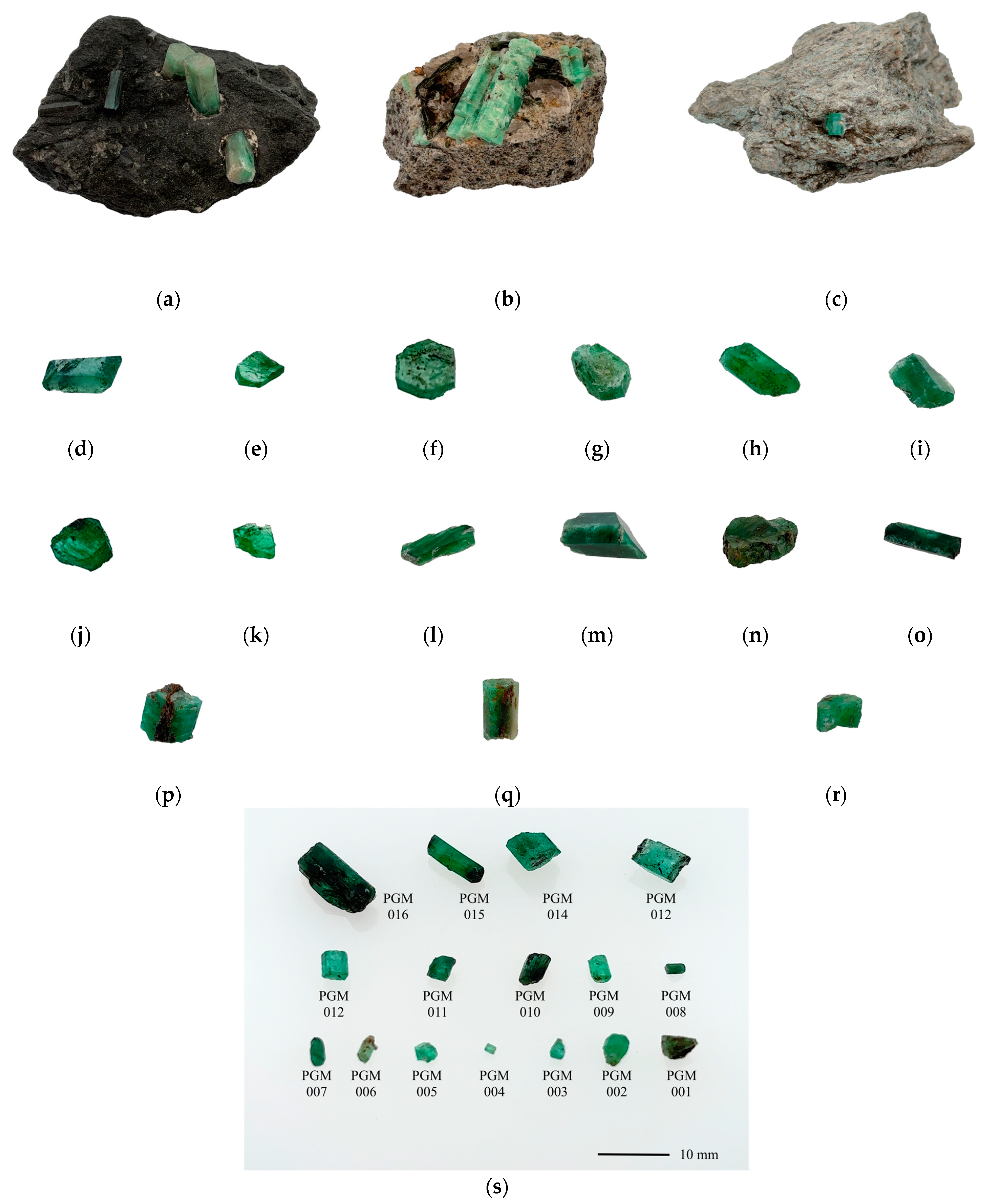
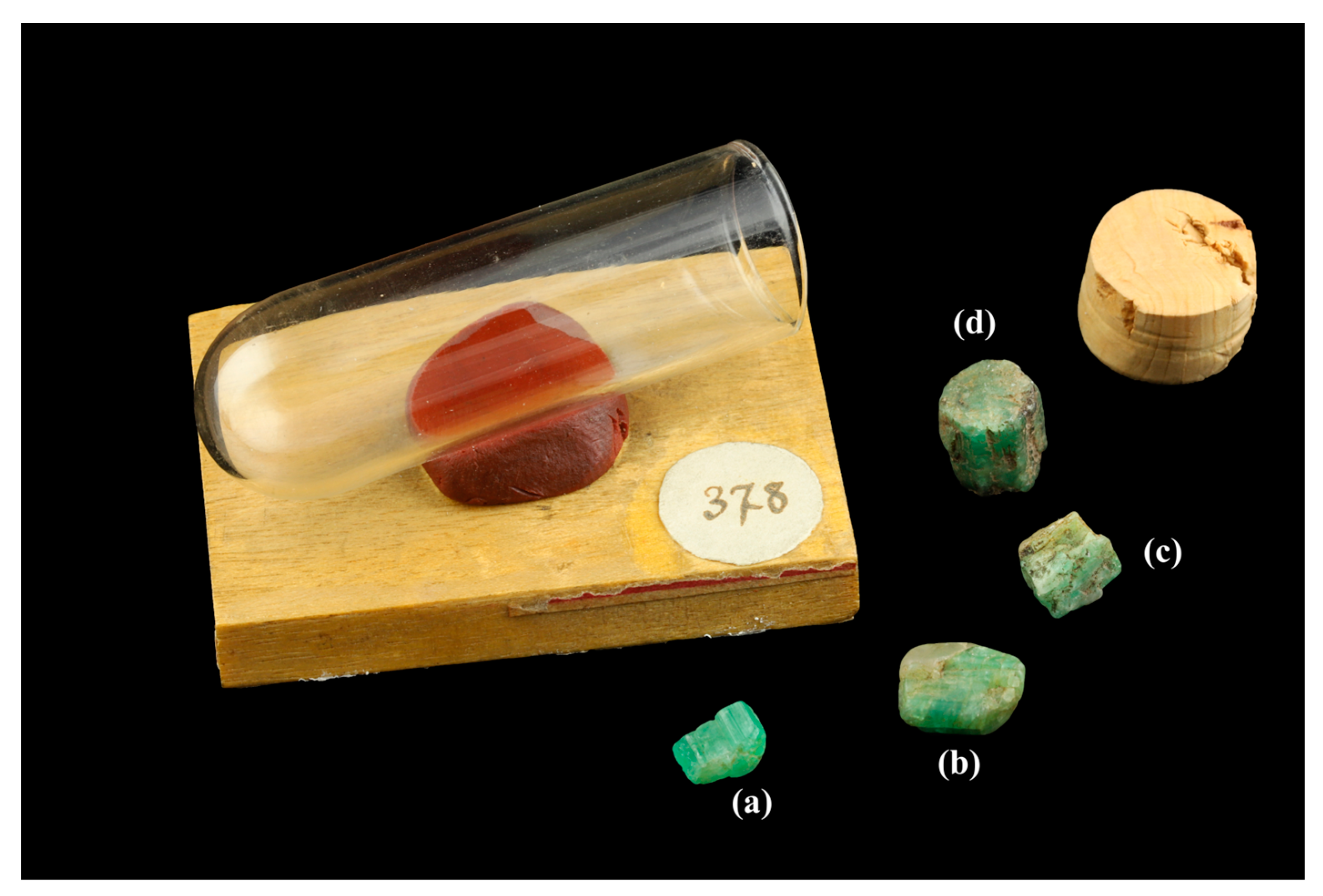
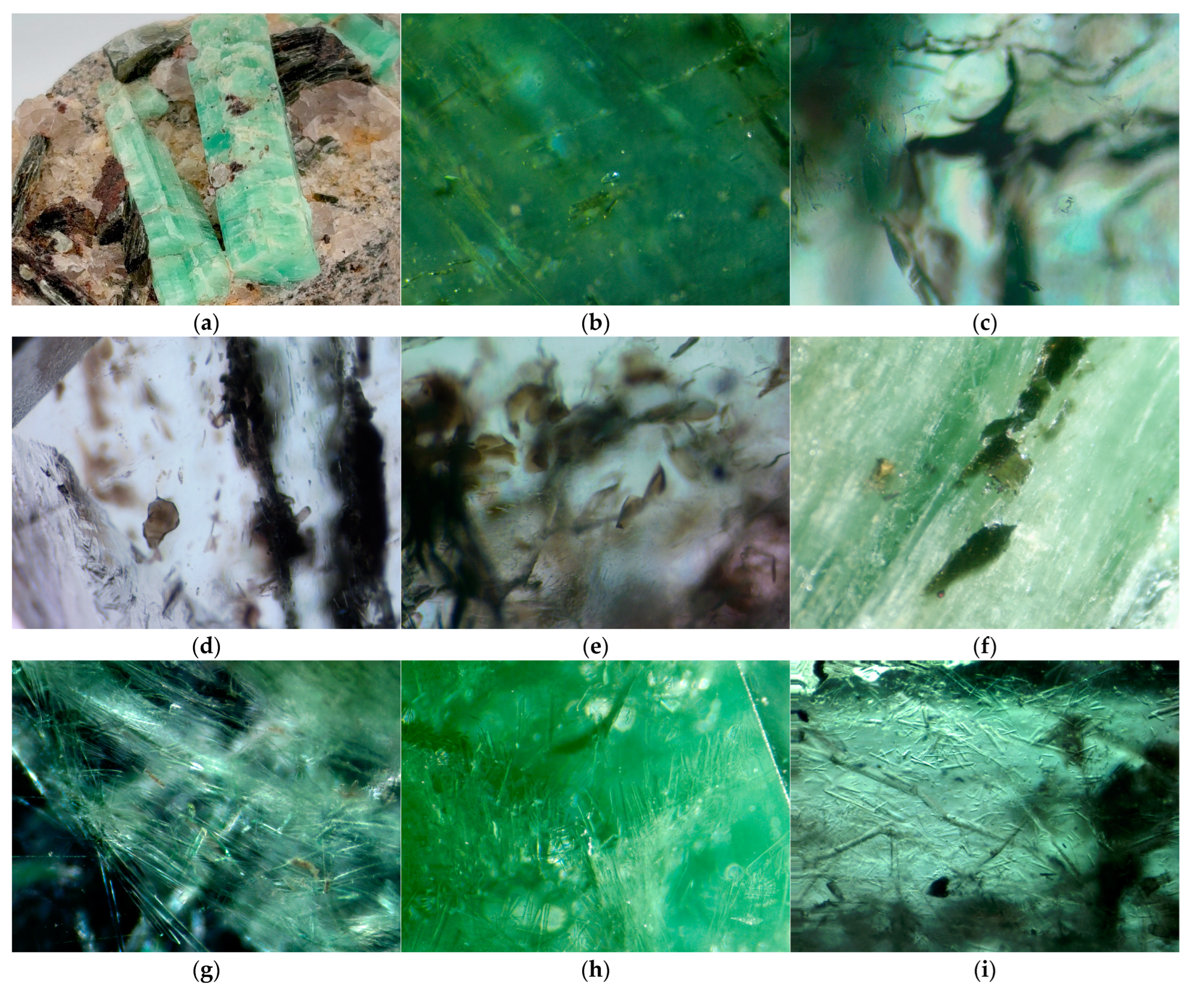

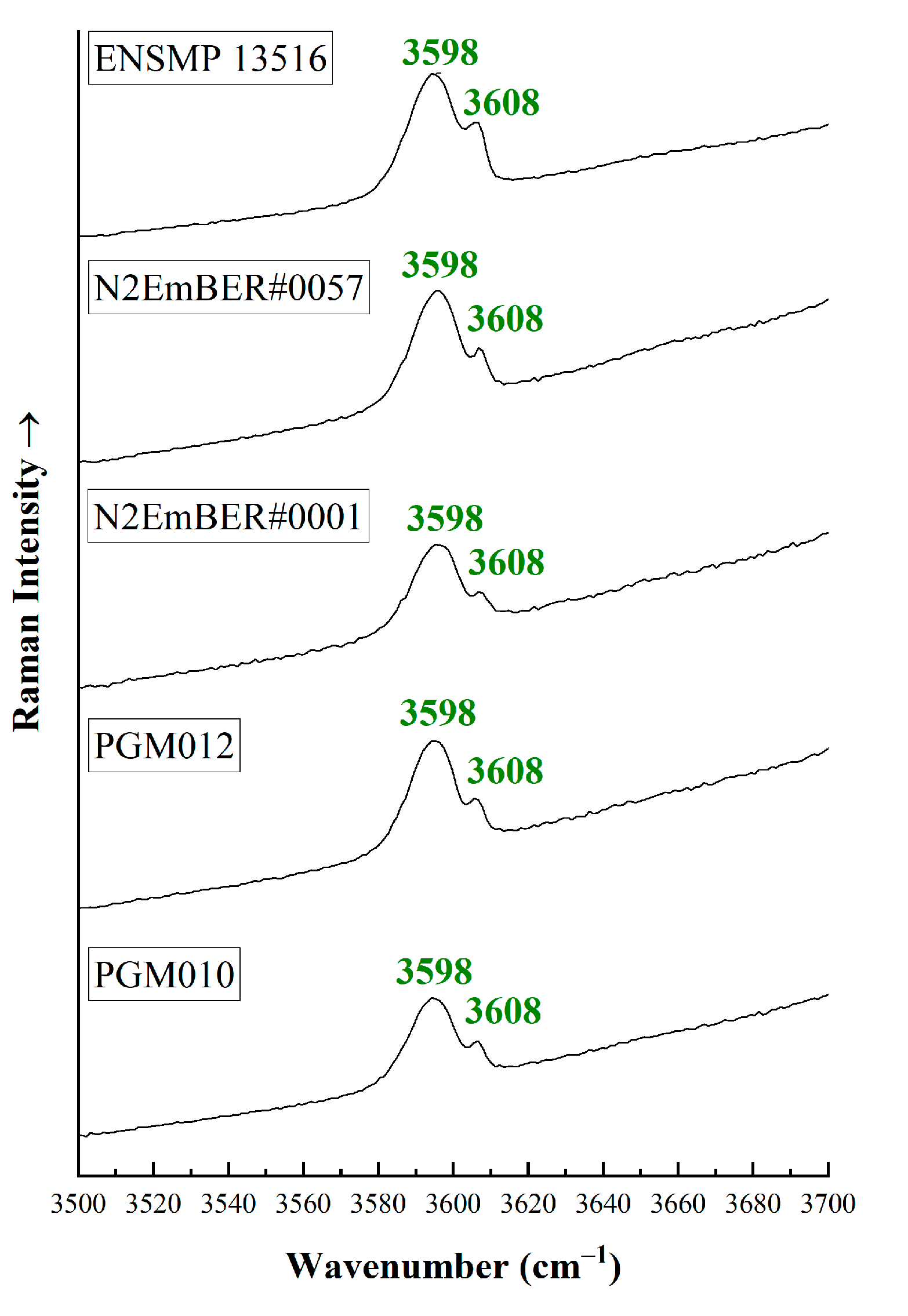
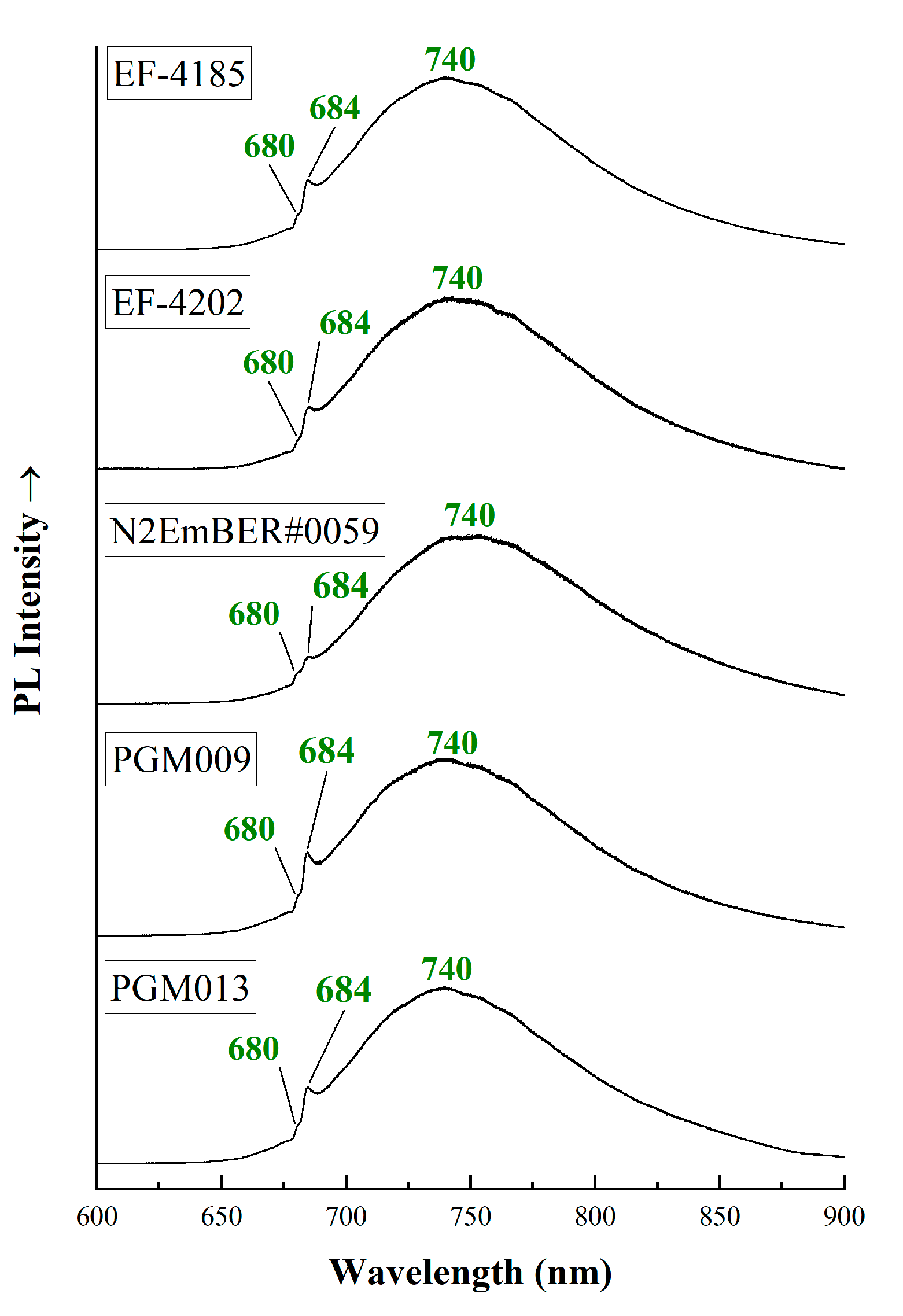
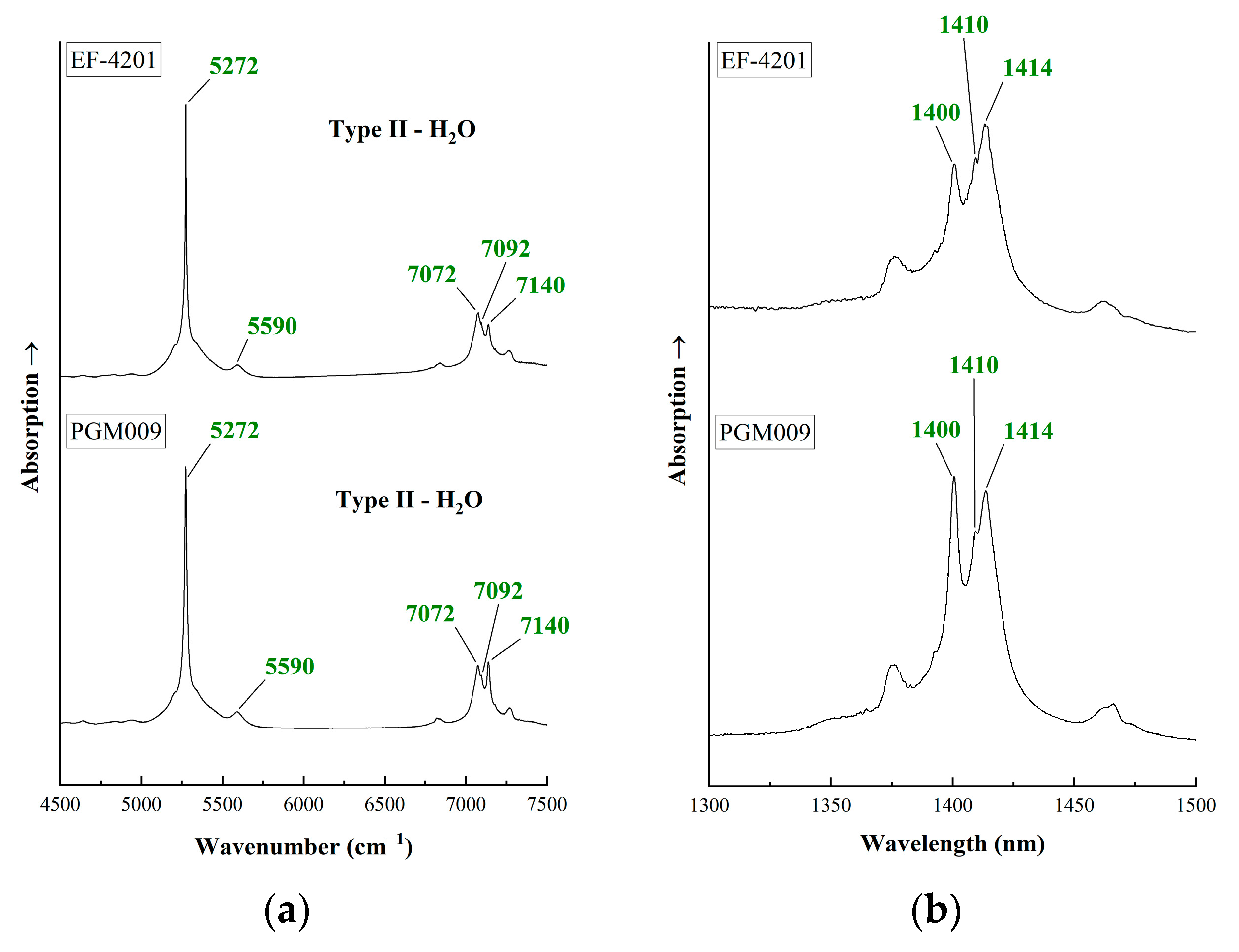


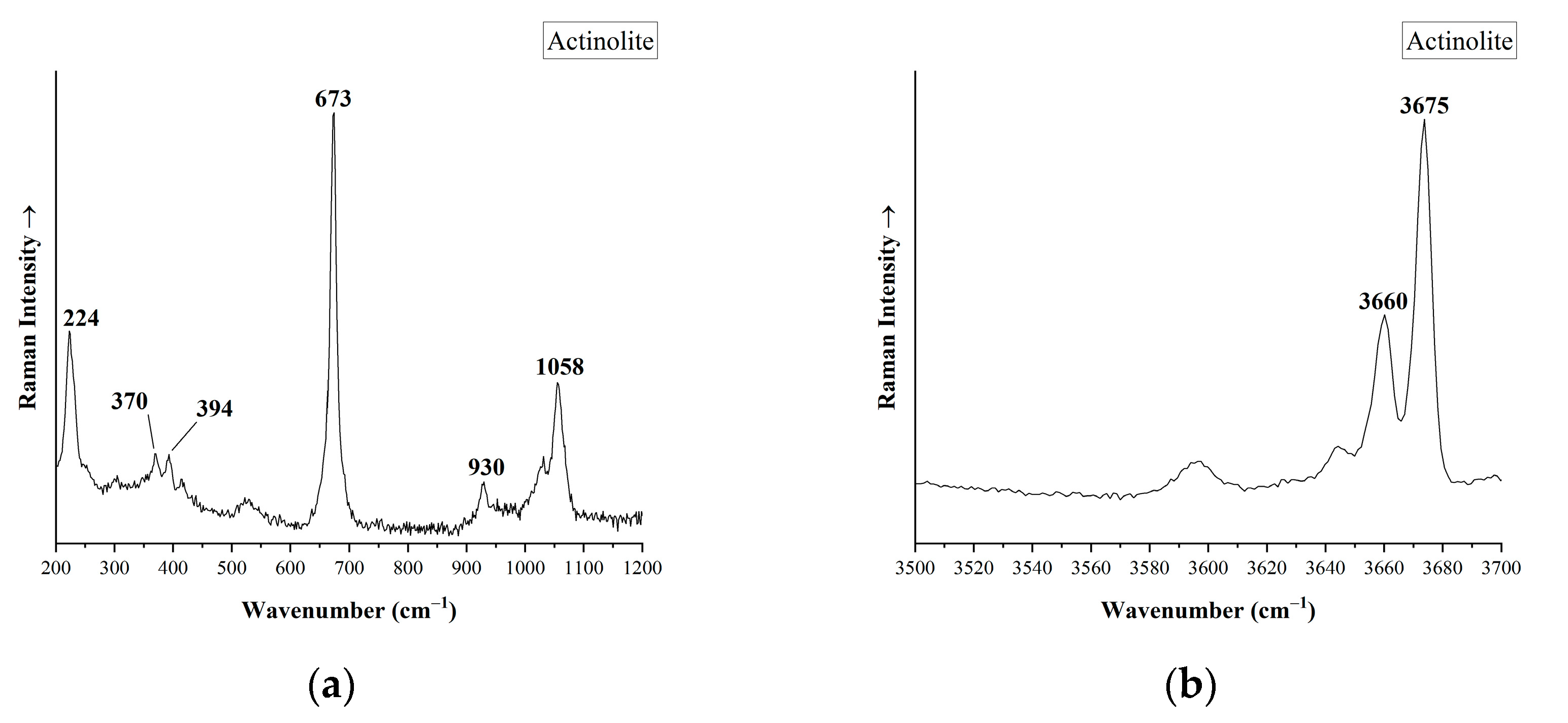
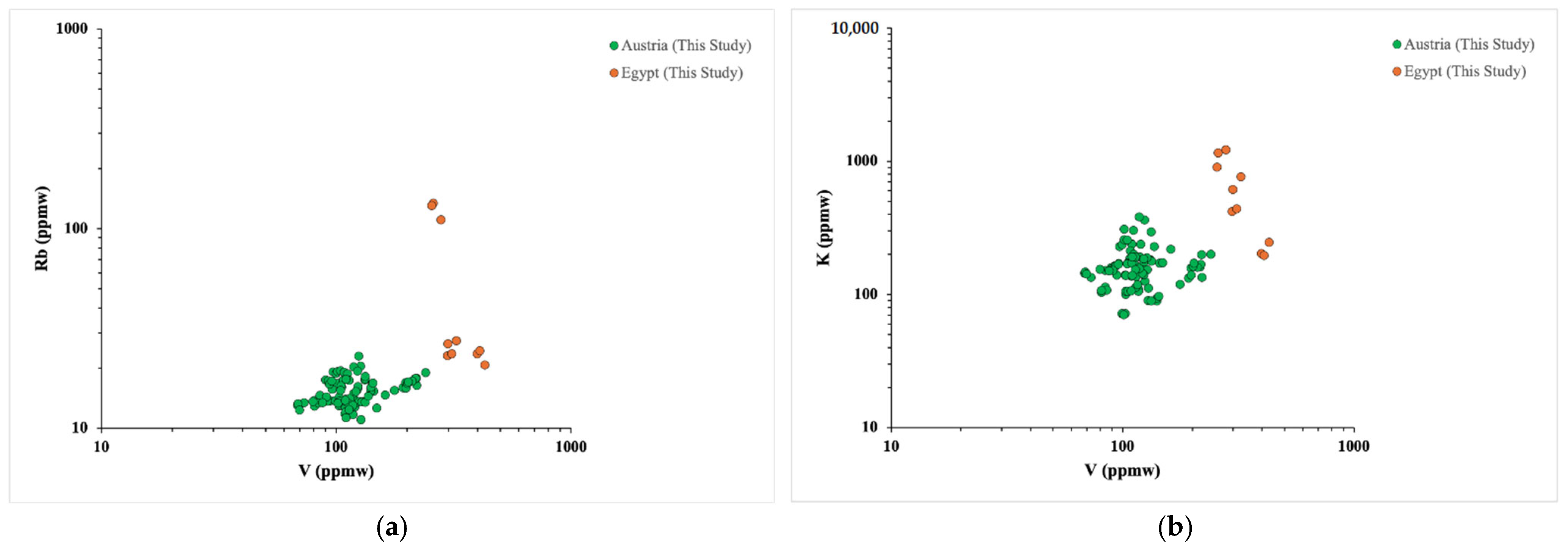
| Reference No. | Dimensions (mm) | Weight Carat (ct.) |
|---|---|---|
| PGM001 | 3.45 × 2.67 × 2.76 | 0.182 |
| PGM002 | 3.63 × 2.44 × 2.55 | 0.153 |
| PGM003 | 1.60 × 2.59 × 1.80 | 0.050 |
| PGM004 | 1.05 × 1.38 × 0.95 | 0.012 |
| PGM005 | 2.87 × 1.36 × 2.44 | 0.055 |
| PGM006 | 2.87 × 1.60 × 1.61 | 0.057 |
| PGM007 | 3.20 × 1.49 × 1.40 | 0.064 |
| PGM008 | 2.05 × 2.30 × 1.30 | 0.034 |
| PGM009 | 3.53 × 2.02 × 1.93 | 0.135 |
| PGM010 | 4.12 × 2.91 × 2.21 | 0.237 |
| PGM011 | 2.70 × 2.57 × 2.95 | 0.191 |
| PGM012 | 4.03 × 2.18 × 2.62 | 0.257 |
| PGM013 | 6.37 × 3.18 × 4.07 | 0.768 |
| PGM014 | 4.68 × 5.42 × 4.44 | 1.126 |
| PGM015 | 8.57 × 2.63 × 2.90 | 0.646 |
| PGM016 | 11.38 × 3.76 × 4.42 | 1.960 |
| N2EmBER#0001 | 4.73 × 3.43 × 1.70 | 0.248 |
| N2EmBER#0002 | 4.29 × 3.74 × 1.33 | 0.165 |
| N2EmBER#0003 | 5.07 × 4.84 × 1.39 | 0.289 |
| N2EmBER#0004 | 4.35 × 3.08 × 2.56 | 0.276 |
| N2EmBER#0005 | 5.35 × 3.16 × 1.85 | 0.250 |
| N2EmBER#0006 | 6.88 × 4.73 × 2.13 | 0.526 |
| N2EmBER#0007 | 4.73 × 3.91 × 2.15 | 0.235 |
| N2EmBER#0008 | 4.08 × 3.15 × 1.52 | 0.132 |
| N2EmBER#0057 | 14.35 × 1.71 × 6.17 | 1.494 |
| N2EmBER#0058 | 15.19 × 7.08 × 8.41 | 5.700 |
| N2EmBER#0059 | 10.74 × 3.40 × 6.66 | 1.995 |
| SK022 | 13.82 × 5.48 × 3.50 | 2.384 |
| EF-4185 | 7.66 × 7.84 × 5.28 | 2.721 |
| EF-4201 | 8.01 × 4.45 × 3.85 | 1.435 |
| EF-4202 | 3.37 × 4.17 × 5.27 | 0.647 |
| * ENSMP 72466_01 | 7.25 × 3.73 × 4.33 | 1.002 |
| * ENSMP 72466_02 | 7.29 × 5.43 × 5.55 | 2.038 |
| * ENSMP 72466_03 | 9.94 × 5.69 × 7.38 | 3.154 |
| * ENSMP 72466_04 | 10 × 7.98 × 8.32 | 5.392 |
| ENSMP 13516 | 92.41 × 62.89 × 47.23 | - |
| PGM021 | 55 × 33 × 42 | - |
| PGM022 | 60 × 42 × 38 | - |
| Oxides | Samples Reference No. | |||||||
|---|---|---|---|---|---|---|---|---|
| N2EmBER# 0002 | N2EmBER# 0003 | N2EmBER# 0004 | N2EmBER# 0006 | N2EmBER# 0008 | N2EmBER# 0001 | PGM014 | SK 022 | |
| V2O3 | 133.7 | 214 | 156 | 206 | 144 | 282 | 309 | 175 |
| Cr2O3 | 2349 | 2269 | 851 | 1853 | 3265 | 1396 | 1442 | 1154 |
| FeO | 10,136 | 15,559 | 9404 | 14,027 | 10,451 | 16,621 | 16,696 | 13,422 |
| Rb2O | 5 | 49 | 30 | 28 | 16 | 25 | 38 | 19 |
| Samples | Elements | Min | Max | Average | Median |
|---|---|---|---|---|---|
| Austria (Habachtal) 27 samples, 95 analyses | Na2O (%) | 1.66 | 2.43 | 2.12 | 2.13 |
| MgO (%) | 1.88 | 3.80 | 2.49 | 2.47 | |
| 7Li | 53.84 | 191.37 | 105.41 | 96.35 | |
| 39K | 70.35 | 383.22 | 163.73 | 157.17 | |
| 45Sc | 2.31 | 359.36 | 80.27 | 51.62 | |
| 47Ti | 0.60 | 194.58 | 12.65 | 6.14 | |
| 51V | 68.37 | 240.53 | 121.87 | 111.82 | |
| 52Cr | 668.34 | 3365.30 | 1737.40 | 1637.05 | |
| 55Mn | 11.44 | 291.20 | 30.11 | 17.92 | |
| 57Fe | 2777.70 | 10,949.62 | 5884.10 | 6192.24 | |
| 59Co | 0.34 | 3.89 | 1.24 | 1.17 | |
| 60Ni | 4.86 | 59.46 | 13.99 | 10.98 | |
| 66Zn | 6.74 | 34.21 | 12.48 | 11.50 | |
| 69Ga | 5.73 | 13.86 | 8.68 | 7.90 | |
| 85Rb | 11.03 | 22.97 | 15.21 | 14.49 | |
| 133Cs | 113.42 | 393.07 | 211.11 | 199.63 | |
| Cr/V | 5.38 | 36.36 | 15.36 | 14.73 | |
| Na2O/MgO | 0.54 | 0.96 | 0.86 | 0.87 | |
| Alkalis * | 1.28 | 1.87 | 1.62 | 1.63 |
| Samples | Elements | Min | Max | Average | Median |
|---|---|---|---|---|---|
| Egypt 4 samples, 10 analyses | Na2O (%) | 1.92 | 2.35 | 2.14 | 2.16 |
| MgO (%) | 2.17 | 2.80 | 2.53 | 2.62 | |
| 7Li | 74.86 | 192.58 | 124.30 | 110.07 | |
| 39K | 196.47 | 1221.62 | 616.85 | 527.21 | |
| 45Sc | 173.08 | 266.36 | 225.46 | 235.77 | |
| 47Ti | 8.93 | 50.94 | 17.29 | 11.42 | |
| 51V | 255.44 | 429.82 | 326.24 | 305.02 | |
| 52Cr | 1000.39 | 2604.22 | 1507.87 | 1265.33 | |
| 55Mn | 17.21 | 64.81 | 29.46 | 24.01 | |
| 57Fe | 4907.16 | 6619.24 | 5444.20 | 5336.65 | |
| 59Co | 1.01 | 3.20 | 1.96 | 1.99 | |
| 60Ni | 16.66 | 31.58 | 23.57 | 23.17 | |
| 66Zn | 13.80 | 348.69 | 71.19 | 31.17 | |
| 69Ga | 9.29 | 15.22 | 12.51 | 12.52 | |
| 85Rb | 20.76 | 133.64 | 54.41 | 25.46 | |
| 133Cs | 141.23 | 327.80 | 198.13 | 188.92 | |
| Cr/V | 2.51 | 8.38 | 4.85 | 4.92 | |
| Na2O/MgO | 0.77 | 0.89 | 0.85 | 0.86 | |
| Alkalis * | 1.47 | 1.83 | 1.69 | 1.75 |
Disclaimer/Publisher’s Note: The statements, opinions and data contained in all publications are solely those of the individual author(s) and contributor(s) and not of MDPI and/or the editor(s). MDPI and/or the editor(s) disclaim responsibility for any injury to people or property resulting from any ideas, methods, instructions or products referred to in the content. |
© 2024 by the authors. Licensee MDPI, Basel, Switzerland. This article is an open access article distributed under the terms and conditions of the Creative Commons Attribution (CC BY) license (https://creativecommons.org/licenses/by/4.0/).
Share and Cite
Nikopoulou, M.; Karampelas, S.; Hennebois, U.; Gruss, P.; Gaillou, E.; Fritsch, E.; Herreweghe, A.; Papadopoulou, L.; Melfos, V.; Kantiranis, N.; et al. Microscopic, Spectroscopic and Chemical Analysis of Emeralds from Habachtal, Austria. Minerals 2025, 15, 22. https://doi.org/10.3390/min15010022
Nikopoulou M, Karampelas S, Hennebois U, Gruss P, Gaillou E, Fritsch E, Herreweghe A, Papadopoulou L, Melfos V, Kantiranis N, et al. Microscopic, Spectroscopic and Chemical Analysis of Emeralds from Habachtal, Austria. Minerals. 2025; 15(1):22. https://doi.org/10.3390/min15010022
Chicago/Turabian StyleNikopoulou, Maria, Stefanos Karampelas, Ugo Hennebois, Pierre Gruss, Eloïse Gaillou, Emmanuel Fritsch, Annabelle Herreweghe, Lambrini Papadopoulou, Vasilios Melfos, Nikolaos Kantiranis, and et al. 2025. "Microscopic, Spectroscopic and Chemical Analysis of Emeralds from Habachtal, Austria" Minerals 15, no. 1: 22. https://doi.org/10.3390/min15010022
APA StyleNikopoulou, M., Karampelas, S., Hennebois, U., Gruss, P., Gaillou, E., Fritsch, E., Herreweghe, A., Papadopoulou, L., Melfos, V., Kantiranis, N., & Delaunay, A. (2025). Microscopic, Spectroscopic and Chemical Analysis of Emeralds from Habachtal, Austria. Minerals, 15(1), 22. https://doi.org/10.3390/min15010022










